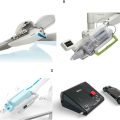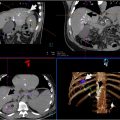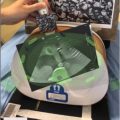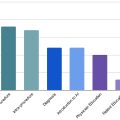Artificial intelligence and robotics are transforming interventional radiology, driven by advancements in computer vision, robotics and procedural automation. Historically focused on diagnostics, AI now also enhances procedural capabilities in IR, enabling future robotic systems to handle complex tasks such as catheter manipulation or needle placement with increasing precision and reliability. Early robotic systems in IR demonstrated improved accuracy in both vascular and percutaneous interventions, though none were equipped with automatic decision-making. This review tends to show the potential in improving procedural outcomes with AI for robotics, though challenges remain. Techniques like reinforcement learning and haptic vision are under investigation to address several issues, training robots to adapt based on real-time feedback from the environment. As AI-driven robotics evolve, IR could shift towards a model where human expertise oversees the technology rather than performs the intervention itself.
Introduction
Artificial intelligence (AI) is profoundly changing the future of radiology, particularly due to the high diagnostic performance of current models. Since the 1950s, computer scientists have worked on enhancing human-like cognitive capabilities of algorithms, with impressive results in combined vision and language models that are slowly gaining acceptance into interventional radiology (IR).
Despite these advances, the potential of AI for enhancing physical capabilities through robotics and image interpretation is less widely understood by interventional radiologists. Our community built a multimodal approach to treating patients with real-time imaging and device manipulation. While the rapid adoption of computer vision in both diagnostic and interventional radiology is indicative of the wide acceptance of its utility in solving many imaging-related challenges, most IRs struggle to find AI applications to their procedural practice.
As interventional radiologists, we believe that our manual skills, such as using specialized devices and guiding them inside the patient, are the most important part of our work. However, this focus on manual capabilities may change with the revolution in robotics and AI—the so-called robolution . As technology advances, AI and robotics will assist in or even take over certain physical tasks that humans currently perform. Robots, guided by AI, could potentially improve precision, reduce fatigue, and allow for more complex procedures, thus changing how IRs approach their work. The rise of robotics in IR could shift the balance from manual skills to more technologically driven practices, where AI and robotics play a bigger role alongside human expertise.
The history of robotics in medicine dates to the 1980s, with the development of the first surgical robots. However, it wasn’t until the late 1990s and early 2000s that robotic systems began to gain significant acceptance into clinical practice. While this technology has led to advances in other fields, its penetration in everyday clinical IR is still limited. Systems like the Da Vinci surgical robot have gained acceptance by the surgical community, and in many procedures, operators utilizing them can augment their agility and improve patient outcomes.
The early stages of robotics in IR focused on percutaneous procedures, with systems primarily assisting in biopsies and tumor ablations. These robots, often guided by CT or fluoroscopy, offered improved accuracy and precision compared to manual techniques. One of the earliest systems was the CT-integrated robot developed by Yanof et al., which demonstrated the feasibility of robotic assistance in percutaneous interventions. The mid-2000s marked a turning point with the introduction of FDA-approved endovascular robotic systems. The Sensei X system (Hansen Medical) emerged as a pioneer in endovascular procedures by enabling remote catheter manipulation. However, these first-generation systems faced limitations in terms of flexibility and range of motion, particularly when navigating small or tortuous vessels.
In this article, we will review the current state of robotics in the field of IR. We will also cover how AI imaging techniques have been increasing the rate of progress in this field.
Current robotic systems in IR and specific AI challenges
AI can tackle the challenges of automated vascular interventions. Current platforms lack force feedback and collision detection, and when manipulating catheters and guidewires, human interventional radiologists are responsible for safety throughout the intervention by both analyzing live images and smoothly advancing or retracting devices.
Achieving automatic decision-making with AI will necessitate a cognitive-like understanding not only of the image produced in the operative settings but also of the tactile force feedback. When a collision occurs, this information can either be seen in the image (the guidewire does not advance, or it kinks) or felt physically by the operator’s hand.
Preliminary research focuses on this specific challenge. Zhang et al. published a magnetorheological fluid (MR)-based robot-assisted catheter/guidewire system which uses haptic cues and human skills acquired through experience to generate collision detection. Similarly, Fagogenesis et al. propose a catheter that uses haptic vision, a hybrid sense using imaging for both touch-based surface identification and force sensing. Despite these advancements, both systems still rely on human supervision and assistance.
We can expect current platforms to develop a recording option that links both the image and the device manipulation. These data could later be used for developing models that learn from real-life experience. In the realm of endovascular therapies, data-driven approaches—particularly advancements in deep reinforcement learning—could help robots achieve more autonomy.
Reinforcement learning (RL) is a type of machine learning where an AI system learns by interacting with its environment and receiving feedback in the form of rewards or penalties based on its actions. In the context of endovascular therapies, this could be applied to a robotic system performing catheter navigation. The robot starts with no knowledge of the best path to take or force to leverage, but through RL, it begins to explore different movements (push, pull, torque). Every time the robot successfully navigates the catheter without damaging the artery, it gets a “reward,” reinforcing that action. If the catheter bumps against the artery wall or causes stress on the vessel, it receives a “penalty,” discouraging those movements.
Over time, through repeated virtual trials, the robot learns to optimize its movements to navigate through the arteries efficiently, avoiding walls and obstacles while minimizing trauma. Eventually, it becomes capable of performing the procedure autonomously with high precision, having learned through trial and error which actions result in the most successful interventions. This continuous feedback loop allows the system to improve its decision-making, making it highly adaptable in complex and dynamic clinical environments.
An alternative method involves working under the supervision of a human. The human operator has the option of disengaging the system at any time. However, any disengagement would be counted as negative feedback requiring adjustments, which will be learned from analysis of the data or from human operator feedback. Positive feedback is derived through accomplishing various objectives during the procedure. Together, over time, these lessons will continuously improve the system.
Below is a list of robotics systems which have been developed for use in the interventional suite. These are summarized in Table 1 .
| Platform | Developer | Regulatory Status | Primary Applications | Notable Findings |
|---|---|---|---|---|
| CorPath GRX | Siemens Healthineers | FDA-cleared, CE-marked | Coronary, peripheral, neurovascular interventions | High technical success; increased procedure times; refocused on neuro in 2023 |
| Magellan Robotic System | Hansen Medical | Discontinued | Uterine fibroid embolization, aortic procedures | Advanced robotic vascular procedures, now discontinued |
| R-One | Robocath | CE-marked | Coronary interventions | Reduced operator radiation exposure, safe in trials |
| Sensei | Hansen Medical | FDA-approved | Cardiac ablation, cardiac mapping, aneurysm repair | Catheter stability; used in cardiac and aneurysm procedures |
| Liberty | Microbot Medical | Preclinical | Guidewire and catheter remote steering | Successful preclinical trials; aiming for FDA approval |
Leading vascular intervention platforms
CorPath GRX (Corindus Vascular Robotics)
The CorPath GRX, developed by Corindus Vascular Robotics (now part of Siemens Healthineers), has received FDA clearance and CE marking for use in a wide range of procedures, including coronary and peripheral vascular interventions, as well as neurointerventions. This versatile system is compatible with off-the-shelf products and offers 5 degrees of freedom (DOF), allowing for precisely controlled catheter manipulation.
The system has demonstrated success in various clinical applications, with recent studies showing promising results in renal artery stenting, PCI, and cerebral aneurysm.
The CorPath GRX system was directly compared to manual interventions in percutaneous coronary interventions in a 2023 study. Seventy patients were enrolled and underwent robotic-assisted PCI (R-PCI). Though there was a 100% technical success rate, 19% of the interventions required manual assistance.
In a major study, 117 patients were treated using the system for embolization of cerebral aneurysms. Technical success was achieved in 94% of cases and seven patients required conversion to manual control for procedure completion.
Magellan Robotic System (Hansen Medical)
The Magellan Robotic System, originally developed by Hansen Medical, utilized dedicated robotic catheters for endovascular procedures. Although the Magellan system has been discontinued, it played a significant role in advancing robotic-assisted vascular interventions.The Magellan system was employed in a diverse range of procedures, including uterine fibroid embolization (UFE) endovascular aortic procedures and carotid artery stenting.
R-One (Robocath)
The R-One robotic PCI system, developed by Robocath, received CE marking in 2019. Like the CorPath GRX, it allows interventionalists to manipulate off-the-shelf guidewires and stent/balloon catheters. The R-One system has been evaluated in a multicenter study (R-ONE EVOLUTION) and has been shown to be safe and effective in the setting of coronary interventions while significantly lowering radiation exposure to the operator.
Sensei (Hansen Medical)
The Sensei system, developed by Hansen Medical, was one of the first commercially available robotic systems to obtain FDA approval in 2007 for use in cardiac mapping and ablative procedures. It enabled remote control of a steerable guide catheter using a 3 DOF joystick. The Sensei system demonstrated potential benefits in terms of catheter stability and was successfully used in cardiac ablation and endovascular aneurysm repairs.
Liberty (Microbot Medical)
Microbot Medical has developed a system that allows for the remote steering of guidewires and catheters. The system is fully disposable and is compatible with off-the-shelf guidewires and catheters. The first clinical case was reported in July 2024 to support future submission to the FDA. Preclinical data on eight pigs, also published in 2024 show that target arteries were catheterized within one minute.
Leading nonvascular intervention platforms and AI
In the field of oncology, especially in percutaneous interventions, precision and reproducibility determine clinical outcomes. Image analysis is essential to accurately target lesions for biopsies and thermal ablations. The latter might require precise needle placement to ensure the treatment coverage, sometimes involving multiple needles for optimal treatment (for example, this feature is essential in irreversible electroporation and cryoablation).
In this context, nonvascular intervention platforms were developed. Most studies indicate no significant increase in complication rates compared to manual techniques. Robotic systems may reduce procedural risks by providing enhanced stability and precision, though this has yet to be proven. Some studies suggest that the long-term benefits—such as reduced procedure times, decreased radiation exposure, and potentially improved clinical outcomes—may outweigh upfront costs. Robotic systems could also offer clear cost advantages in underserved areas. In regions where ready access to a full-time interventional radiologist may not be financially feasible, remotely operated systems could allow IRs from other geographic locations to perform procedures as needed.
The incorporation of artificial intelligence into current robotic technologies is set to enhance treatment planning and needle placement. AI could analyze real-time imaging data to guide robotic systems, thus optimizing needle trajectories—though this is not standard practice yet. By leveraging deep learning, AI can assess factors such as physical structures in real-time and facilitate automated adjustments in response to patient movement or deviation.
Below is a list of current systems, it is summarized in Table 2 .
| Name | Manufacturer | Degrees of Freedom | Guidance Technology | Compatibility | Approval Status | Procedures Supported | Key Features |
|---|---|---|---|---|---|---|---|
| Cone Beam Assisted Guidance | Various | N/A | Fluoroscopic guidance | Fluoroscopy | N/A | Lesion biopsy, ablation, Adrenal vein sampling | Reduces radiation dose, allows unorthodox guidance |
| Electromagnetic Navigation | Imactis | N/A | Electromagnetic field tracking | CT | N/A | Biopsies, Ablations | Real-time needle tracking, reduces radiation exposure |
| AcuBot | URobotics Laboratory Johns Hopkins University | 6 | Robotic assistance | CT | FDA-approved | Nerve blocks, Facet blocks, Ablations | High accuracy in needle placement |
| B-Rob II | ARC Seibersdorf Research | 7 | Robotic assistance | CT, US | N/A | CT and US-guided biopsies | Improves accuracy, reduces procedure times, integrates with multiple radiological systems |
| iSYS1 | Medizintechnik | 4 | Robotic assistance | CT, Fluoroscopy, CBCT | CE-marked, FDA-approved | Biopsies, Catheter placements | Manual and automatic needle movement, integrates with third-party planning software |
| Micromate™ | Medizintechnik | N/A | Robotic assistance | CT | FDA-approved | Biopsies, Drainages, Ablations | Manual and automatic device movement, accurate needle placement |
| Zerobot | Okayama University | 6 | Remote controlled robotics | CT | FDA approved | Biopsies, Drainages, Ablations | High accuracy and safety in phantom, animal, and early clinical trials |
| ROBIO EX | Perfint Healthcare | 4 | Robotic assistance | CT, PET-CT | CE-marked | Biopsies, Drainages, Ablations | Breath-hold management system to handle respiratory motion |
| MAXIO | Perfint Healthcare | 5 | Robotic assistance | CT | CE-marked, FDA-Approved | Needle placement assistance | Steep learning curve, facilitates effective placement for novice operators |
| EPIONE | Quantum Surgical | 6 | Robotic assistance | CT | CE-marked, FDA-Approved | Needle placement assistance | High accuracy and safety in preclinical and clinical trials |
| INNOMOTION | Innomedic | 6 | Robotic assistance | CT, MRI | CE-marked | Instrument positioning within MRI | High accuracy under MR guidance |
Stay updated, free articles. Join our Telegram channel

Full access? Get Clinical Tree








